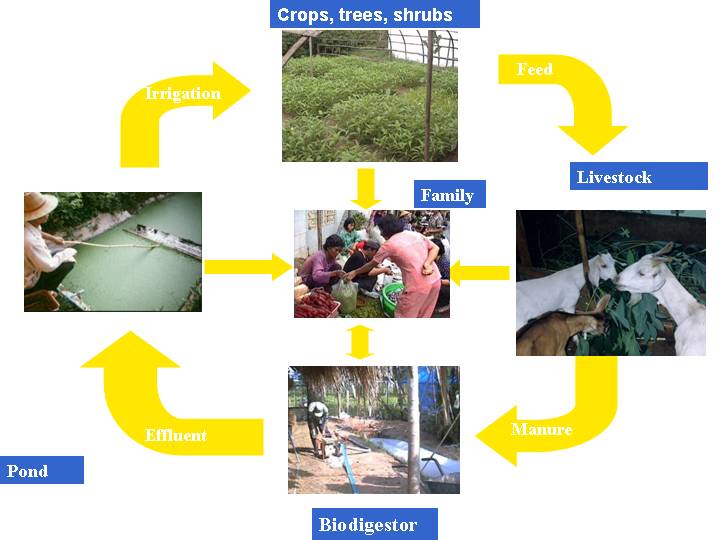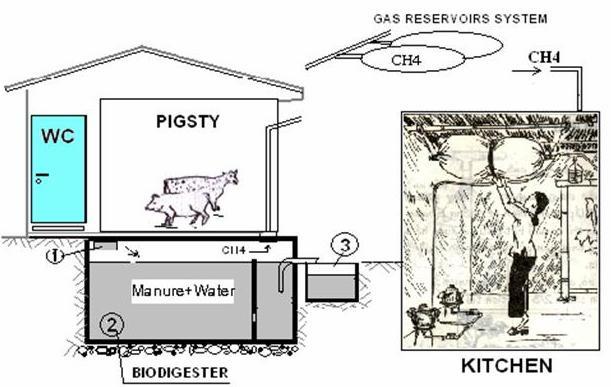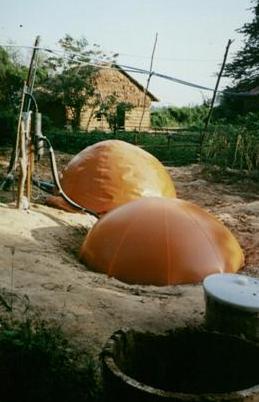Low-cost biodigesters as the epicenter of
ecological farming systems
T R Preston and Lylian Rodríguez
University
of Tropical Foundation ,
Cambodia
Abstract
Much of the developmental work
with biodigesters has been approached from the engineering viewpoint with
emphasis on design and construction with the aim of maximizing gas production
and efficiency of conversion of feedstock to biogas. There has been very little change in the
basic designs of the floating canopy (as developed in
The introduction of the
low-cost (< USD 50.00 for a family size unit) plastic biodigester, based on
the use of tubular polythene film, put the technology within reach of a greater
number of end users (more than 20,000 users in
Future needs are: to document the observed improvement in
fertilizer value of the biodigester effluent compared with the raw manure; to
understand the factors influencing this process; and to improve the design of
the low-cost plastic biodigester so as to increase efficiency and rates of gas
production.
Key words:
Biodigesters, farming system, effluent, fertilizer, design and
construction
Introduction
Biodigesters have been considered primarily as a means of
producing a combustible gas from waste organic matter, derived from animals or
people. In this respect, the
developers of this technology have been mainly concerned with details of the
design and construction of biodigesters, and of management strategies, which
would lead to maximum rates of gas production. Less attention was given to the other
output from the biodigester, namely the effluent resulting from the digestion
process.
As a result of the increasing emphasis on the promotion of
farming systems based on the sustainable use of natural resources, it is now
appreciated that the biodigester should be considered in a much wider
perspective and specifically in its potential role for the recycling of plant
nutrients. This process has
implications both as a means of reducing the dependence on inorganic fertilizers
and for facilitating the production of foods and feeds of organic origin.
The biodigester in the farming system
For farming systems to be sustainable there should be a close
relationship among the different components that interact in the conversion of
solar energy and soil nutrients into food of animal and plant origin for the
benefit of both the consumer and the producer (Figure 1).

Figure 1:
The integrated farming
system
Seen in this context the biodigester plays several roles. It can be:
- A source of fuel for
cooking
- A source of fertilizer
for:
- Crops
- Water plants
- Fish ponds
- Crops
- A means of de-contaminating wastes rich in
organic matter
The appropriate use of biodigesters can also give rise to a
number of related socio-economic benefits that come about through improvements
to:
- The quality of life for rural women and
children due to:
- Reduced workload (less firewood has to be
collected!!)
- Cleaner kitchen and cooking
utensils
- Reduced workload (less firewood has to be
collected!!)
- The fertilizer value of manure
- Organic N is converted to
NH4-N
- Organic N is converted to
NH4-N
- The environment
- Reduced methane
emissions
- Less deforestation
- Reduced methane
emissions
Research on the biodigestion process should therefore proceed along a number of pathways, namely:
- Design and construction, with the aim of reducing installation costs and / or improving the efficiency of converting the input materials into usable end-products
- Changes that take place in the biological and chemical characteristics of the substrate during the process of biodigestion
- Use of the effluent as fertilizer for soil and water plants and for fish ponds
Design and construction of the biodigester
Much of the developmental work with biodigesters has been
approached from the engineering viewpoint with emphasis on design and
construction with the aim of maximizing gas production and efficiency of
conversion of feedstock to biogas.
There has been very little change in the basic designs of the floating
canopy (as developed in
The introduction of the low-cost (< USD 50.00 for a family
size unit) plastic biodigester, based on the use of tubular polyethylene film
(Botero and Preston1985; Bui Xuan An et al 1997a,b), put the technology within
reach of a greater number of end users. It has been estimated that there are
more than 15,000 users of this technology in
The Hybrid Technology Biodigester with
Automatic Scum Control (HTASC)
This modification of the low-cost plastic biodigester system (VACVINA 1998) was directed at improving
the durability of the digestion chamber by constructing it from bricks and
cement. The HTASC is a cross between an underground
fixed dome (Chinese) model and a plastic-bag model. The main digestion chamber
is a rectangular (flat-topped) low-depth underground cement tank. There is no
pre-digestion / mixing chamber, but instead a siphon-type input with active and
continuous scum-breaking action. The effluent is gravity fed to a secondary
chamber. This design facilitates the integration of the livestock pen and
household latrine with the biodigester, thus saving space and reducing the
overall costs of construction (Figure 2).
Positive results with this digester design have been reported
from Vietnam (VACVINA 1998), however, it has been less successful in a pilot
test in Cambodia, due apparently to gas leakage through the walls and /or roof
of the digestion chamber, which was only resolved by connecting the input
siphons to the traditional polyethylene model (http://www.utafoundation.org/recdevel.htm
and Preston T R 2001, unpublished
observations). The idea is an
interesting one which merits further research and, specifically, the development
of appropriate techniques to ensure the concrete surfaces are gas-tight.

The “Super-gas” mixing system
The objective behind the development of this model is to increase the rate and efficiency of the gas production from the substrate by using the gas pressure generated in the reactor to trigger the movement of the substrate between the reactor and the reservoir chambers. The digester is made from PVC sheets welded into a “balloon”. Two balloons are inter-connected to permit free movement of the substrate from one to the other and a simple “water” valve controls the build-up and release of the gas pressure (Figure 3).

Figure 3:
The “super-gas” mixing biodigester
installed in UTA,
The biodigestion process
The changes that take place in the substrate during the
digestion process have received less attention and have been concerned mainly
with environmental and health issues.
Thus the degree of reduction in the Biological Oxygen Demand (BOD) and in
the concentration of pathogenic micro-organisms have been major areas of
interest (Chara et al 1999; Vieyra 2000;
Pedraza et al 2002).
Recently, attention has focused more on the fertilizer value
of the effluent and specifically on comparisons of the effluent with the raw
manure used to charge the digesters. Thus Le Ha Chau (1998a) showed that the
biomass yield and the protein content of
cassava foliage were significantly increased when biodigester effluent,
derived from either pig or cow manure, was used to fertilize the cassava as
compared with the same amount of nitrogen applied in the form of the raw manure
used to charge the biodigester.
Similar findings were reported for duckweed grown in ponds fertilized
with the effluent or the raw manure (Le Ha Chau 1998b). Kean Sophea and
Reports from
Conclusions
The increasing emphasis on the need to develop agricultural
practices that are in harmony with the environment, and which make maximum use
of local resources, is creating a
favourable climate for promotion of biodigester technology. Future research in this area
should focus on the role of the biodigester as an integral component of the
farming system, with major emphasis on ways to optimize the fertilizer value of
the effluent and its use on crops and in ponds for water plants and fish. There
is opportunity for improvement in the design and management of low-cost plastic
biodigesters in order to make them more productive and efficient.
References
Botero R
and Preston T R 1987
Biodigestor de bajo
costo para la produccion de combustible y fertilizante a partir de excretas.
Manuscrito ineditado: CIPAV, Cali, Colombia
Bui Xuan An,
Bui Xuan An, Rodríguez L, Sarwatt S
V, Preston T R and Dolberg F 1997b Installation and performance of low-cost
polyethylene tube biodigesters on small-scale farms. World Animal
Review Number 88 FAO Rome http://www.fao.org/ag/AGA/agap/frg/feedback/war/W5256t/W5256t06.htm#TopOfPage
Chara J,
Pedraza G X and Conde Natalia 1999 The productive
water decontamination system: A tool for protecting water resources in the
tropics. Livestock Research for Rural Development (11) 1: http:/www.cipav.org.co/lrrd/lrrd11/1/cha111.htm
Ding Jieyi and Han Yujin 1984
Comparative studies on the effects of
fresh pig manure and anaerobically fermented pig
manure upon fish farming, Proceedings Integrated Fish
Farming Systems. Fresh Water Fisheries Research Centre of
Kean Sophea and
Le Ha Chau
1998a Biodigester effluent versus manure from pigs or cattle as
fertilizer for production of cassava foliage (Manihot
esculenta). Livestock Research for Rural Development (10)
3: http://cipav.org.co/lrrd/lrrd10/3/chau1.htm
Le Ha Chau 1998b
Biodigester effluent versus manure, from pigs or
cattle, as fertilizer for duckweed (Lemna spp.). Livestock Research for Rural Development (10)
3: http://cipav.org.co/lrrd/lrrd10/3/chau2.htm
Pich Sophin and
VACVINA 1998 Hybrid Technology Biodigester with
Automatic Scum Control (HTASC). Center for Rural Communities.
Vieyra R R 2000 Monitoreo de biodigestor de bajo costo usando